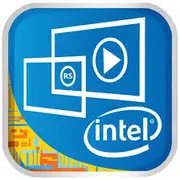Intel Core M-5Y10c

Intel Core M-5Y10c: Review and Recommendations for Users in 2025
Analysis of the ultra-mobile processor for thin devices
Architecture and Technology Process: Evolution of Energy Efficiency
The Intel Core M-5Y10c processor, released in 2014-2015, became part of the Broadwell line—Intel's fifth-generation architecture. This chip was one of the first created using a 14nm technology process, which allowed for reduced power consumption and lower heat generation.
- Cores and Threads: 2 physical cores with Hyper-Threading support (4 threads).
- Clock Frequencies: Base frequency is 800 MHz, maximum in turbo mode is 2 GHz.
- Graphics Accelerator: Intel HD Graphics 5300 (24 EU, frequency up to 800 MHz).
A key feature of the Broadwell architecture is its optimization for mobile devices. The chip supports AVX2 instructions, enhancing performance in vectorized tasks, but due to its low TDP, its potential is rarely fully realized. The HD 5300 graphics can handle 4K video decoding, but it is not suitable for gaming.
Power Consumption and TDP: A Revolution in Compactness
The processor's TDP (Thermal Design Power) is only 4.5 W. This allowed for the creation of laptops without active cooling (fans), making devices thinner (down to 9 mm) and lighter (less than 1 kg). For example, the 2015 Apple MacBook 12" lineup used similar Core M chips.
How It Works:
- The processor dynamically adjusts frequency based on load.
- During peak tasks (like opening a browser), turbo mode activates, but due to TDP limitations, it lasts only briefly (10-20 seconds).
Performance: Real-World Tasks and Limitations
In Geekbench 6 tests (Single Core — 593, Multi Core — 1156), the Core M-5Y10c lags behind even budget modern processors from 2025. However, for basic tasks, it remains functional:
- Office Tasks: Microsoft Office, Google Docs, email — no problems.
- Multimedia: 4K video playback (via YouTube or local files), photo editing in Lightroom (for simple retouching).
- Gaming: Only older games (like Half-Life 2) or browser-based projects on low settings.
Turbo Boost mode temporarily raises the frequency to 2 GHz, but under prolonged load (like video rendering), the processor throttles, reducing performance back to base levels.
Use Cases: Who Is the Core M-5Y10c Suitable for in 2025?
This processor is relevant for niche markets:
1. Ultra-portable Devices: Convertible laptops (like the ASUS Transformer Mini) or tablets with keyboards.
2. Secondary Devices: For travel or as an addition to a main PC.
3. Education: School laptops for text work and educational applications.
Not Suitable For:
- Gamers and designers.
- Users working with heavy software (video editing, 3D modeling).
Battery Life: How Long Does the Device Last?
Thanks to its 4.5 W TDP, laptops with the Core M-5Y10c provided up to 9-10 hours of use in 2015. In modern 2025 models (with optimized OS and SSD), battery life can reach 7-8 hours due to:
- Intel Technologies: SpeedStep (frequency adjustment), C-States (turning off unused cores).
- Display Efficiency: Many ultrabooks with this chip use low-power displays (like e-ink panels in hybrid devices).
Comparison with Competitors: Against AMD and Apple
In its segment (2014-2016), the Core M-5Y10c competed with:
- AMD A6-8500P (15 W TDP, 2 cores): Better graphics (Radeon R5), but higher power consumption.
- Intel Core i5-5200U (15 W TDP): Significantly more powerful but requires active cooling.
In 2025, similar TDP chips include Apple M1 (in base iPads) and Qualcomm Snapdragon 8cx (for Windows tablets). They outperform the Core M by 3-4 times in performance with similar battery life.
Pros and Cons: Is It Worth Buying in 2025?
Pros:
- Silent operation (no fans).
- Compact devices.
- Low price: Laptops with this processor in 2025 cost $250-$400 (new models from stock).
Cons:
- Low performance for modern tasks (like running AI-based applications).
- Limited OS support: Some Linux distributions and Windows 11 require workarounds for installation.
Recommendations for Choosing a Laptop
If you are considering a device with the Core M-5Y10c in 2025, pay attention to:
1. Device Type: Ultrabook or convertible tablet (like the Lenovo Yoga 3 Pro).
2. Display: Full HD or higher — for comfortable work.
3. Storage: SSD is a must (minimum 128 GB).
4. Ports: USB-C with charging support — for versatility.
Example Model:
- HP Spectre x2 (2015) — 12" screen, 8 GB RAM, 256 GB SSD. In 2025, such devices can be found for $300-$400 among new stock.
Final Conclusion: Who Is This Processor For?
The Intel Core M-5Y10c is a relic but practical choice for:
- Minimalists: Those needing an inexpensive laptop for reading, web browsing, and document work.
- Travelers: Lightweight devices with long battery life.
- Secondary Devices: For instance, connecting to a monitor as a "workstation" in the kitchen.
Key Benefits: Price, portability, silence. However, for most users in 2025, devices based on ARM chips (Apple M1, Snapdragon X) or budget Intel Core i3 from the 12th generation will be a more justified choice.
Note: All prices are valid as of April 2025 and relate to new devices available on the market.
Basic
CPU Specifications
Memory Specifications
GPU Specifications
Miscellaneous
Benchmarks
Compared to Other CPU
Share in social media
Or Link To Us
<a href="https://cputronic.com/cpu/intel-core-m-5y10c" target="_blank">Intel Core M-5Y10c</a>